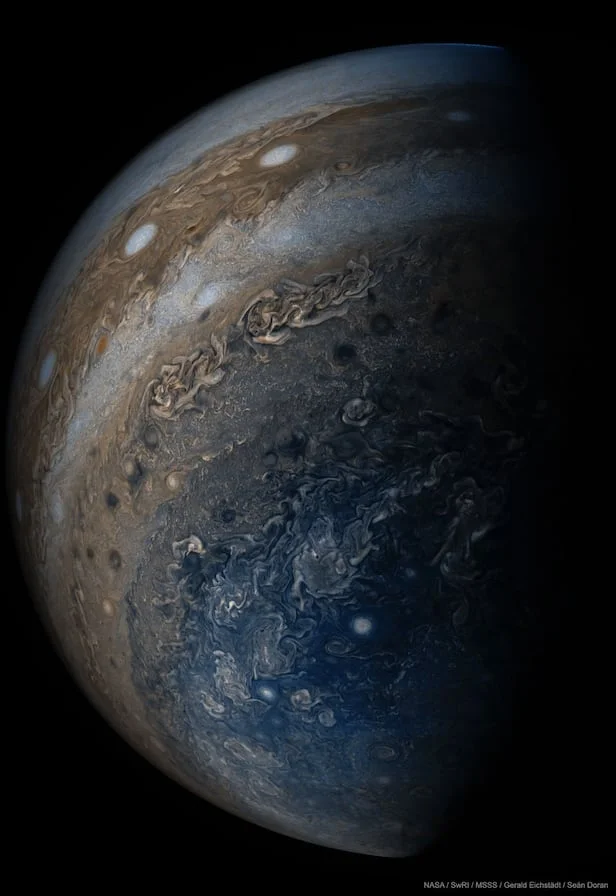
NASA’s Juno Mission Delivers Stunning Jupiter Insights: Final Flybys Reveal Volcanic Moon Io in Unprecedented Detail
NASA's Juno mission is nearing its end, but not before delivering a treasure trove of groundbreaking discoveries about Jupiter and its moons. Recent flybys, particularly the 72nd perijove on May 8, 2025, have provided unprecedented views of Jupiter's turbulent atmosphere and the volcanic moon Io. These images and data are not only visually stunning but also crucial for understanding the dynamics of gas giants and their impact on surrounding moons.
Jupiter's extreme environment continues to fascinate scientists. Scott Bolton, principal investigator of Juno, aptly described the planet: “Everything about Jupiter is extreme… a place to gigantic polar cyclones bigger than Australia, fierce jet streams, the most volcanic body in our solar system, the most powerful aurora, and the harshest radiation belts.” Juno's mission has provided a closer look at the immense energy wielded by this gas giant.
One of the most remarkable achievements of the Juno mission has been the detailed observation of Io's volcanic activity. By combining Microwave Radiometer (MWR) data with Jovian Infrared Auroral Mapper (JIRAM) data, scientists have gained insights into the moon's subsurface temperature profile.
"When we took in the MWR data with JIRAM’s infrared imagery, we were amazed by what we saw: evidence of still-warm magma that hasn’t yet solidified below Io’s cooled crust. At every latitude and longitude, there were cooling lava flows," said Shannon Brown, a Juno scientist at NASA’s Jet Propulsion Laboratory. The data suggests that about 10% of Io's surface has remnants of slowly cooling lava just beneath the surface, providing clues about how the moon rapidly renews its surface and how heat moves from its deep interior.
The most energetic eruption in Io's history, observed during Juno's December 27, 2024, flyby, was still spewing lava and ash as recently as March 2. Scientists anticipate further observations on May 6, as Juno continues its surveys.
Juno's radio occultation experiments have also yielded significant findings. Initial temperature measurements of Jupiter’s north polar stratospheric pictures show the region is about 11 degrees Celsius cooler than its surroundings and is encircled by winds exceeding 100 mph (161 kph).
The mission has also shed light on the long-term movement of Jupiter's massive northern polar cyclone and the eight cyclones that encircle it. Unlike hurricanes on Earth, Jupiter's cyclones are confined to the polar region and cluster together as they approach the pole. This behavior provides insights into cyclone dynamics and the influence of the Coriolis force.
Adding to the intrigue, NASA's Juno captured stunning images of Jupiter on May 8, 2025, during its 72nd perijove. These images, processed by citizen scientists, showcase the planet's dramatic cloud bands and turbulent storms. JunoCam, despite early overheating issues, continues to deliver valuable visual data, complementing the data collected by Juno’s other instruments, including a magnetometer, a gravity science system, and a microwave radiometer.
The Juno mission is scheduled to conclude with its 76th perijove on September 15, 2025, with a deliberate "death dive" into Jupiter to prevent any accidental impact on Europa, a moon suspected of harboring conditions for life. While Jupiter will be relatively quiet until 2030, NASA’s Europa Clipper will arrive to study Europa, followed by the European Space Agency’s JUICE spacecraft in 2031, which aims to explore Europa, Callisto, and Ganymede.
Juno's legacy lies in its detailed exploration of Jupiter's atmosphere, magnetic field, and moons, setting the stage for future missions that will continue to unravel the mysteries of the gas giant, Io's volcanoes and the potential for life on icy moons like Europa. What are your thoughts on the striking differences that Juno has revealed between Jupiter's cyclones and Earth's hurricanes?
Share your thoughts and insights in the comments below!